These archive pages are provided in order to make it easier for you to find items
that you remember seeing on the Airplanes and Rockets homepage. Of course probably
the easiest way to find anything on the website is to use the "Search AAR" box at
the top of every page.
1 |
2 |
3 |
4 |
5 |
6 |
7 |
8 |
9 |
10 |
11 |
12 |
13 |
14 |
15 |
16 |
17 |
18 |
19 |
20
21 |
22 |
23 |
24 |
25 |
26 |
27 |
28 |
29 |
30 |
31 |
32 |
33 |
34 |
35 |
36 | 37
| 38 | 39
 In the same manner that radio control model
aircraft are today under scrutiny by government regulating agencies (DHS, FBI, et
al), model rocketry suffered various forms of discrimination in its early days of
widespread popularity. Per this 1963 article from American Modeler magazine,
"The status of model rocketry under the law has often been a questionable one in
several sections of the country. Our hobby has been variously labeled as fireworks,
handling and discharging explosives, public nuisance (which covers a multitude of
sins), disturbance of the peace, a hazard to aircraft in flight, dangerous to persons
and property on the ground, and 'dangerous
killer.' As the record shows it is none of these." The more things change, the
more they stay the same; ignorance is NOT bliss... In the same manner that radio control model
aircraft are today under scrutiny by government regulating agencies (DHS, FBI, et
al), model rocketry suffered various forms of discrimination in its early days of
widespread popularity. Per this 1963 article from American Modeler magazine,
"The status of model rocketry under the law has often been a questionable one in
several sections of the country. Our hobby has been variously labeled as fireworks,
handling and discharging explosives, public nuisance (which covers a multitude of
sins), disturbance of the peace, a hazard to aircraft in flight, dangerous to persons
and property on the ground, and 'dangerous
killer.' As the record shows it is none of these." The more things change, the
more they stay the same; ignorance is NOT bliss...
 "...the new World War has clamped down the
screens of censorship, hence we shall be lucky to get anything much in the way of
info and pictures on new equipment to be used by the warring nations." That appeared
in the December 1939 issue of Flying Aces magazines. Most people here in
America think of World War II beginning on December 7th, 1941, with the Japanese
attack on Pearl Harbor. In actuality, the war began much sooner with Hitler's and
Hirohito's invasions in Europe (and North Africa) and Asia (South China and South
Pacific), respectively. The accepted start date is September 1, 1939, following
Hitler's invasion of Poland. Since a December magazine issue typically went to press
in October or October, the war had only begun a month or two earlier. Of particular
interest here (to me, anyway) is the
Curtiss XP−42, obviously a modification of the P−40 Warhawk, but with a noticeably
different cowl. Its shape suggests an inline type engine, but reportedly it housed
a Pratt & Whitney Twin Wasp radial... "...the new World War has clamped down the
screens of censorship, hence we shall be lucky to get anything much in the way of
info and pictures on new equipment to be used by the warring nations." That appeared
in the December 1939 issue of Flying Aces magazines. Most people here in
America think of World War II beginning on December 7th, 1941, with the Japanese
attack on Pearl Harbor. In actuality, the war began much sooner with Hitler's and
Hirohito's invasions in Europe (and North Africa) and Asia (South China and South
Pacific), respectively. The accepted start date is September 1, 1939, following
Hitler's invasion of Poland. Since a December magazine issue typically went to press
in October or October, the war had only begun a month or two earlier. Of particular
interest here (to me, anyway) is the
Curtiss XP−42, obviously a modification of the P−40 Warhawk, but with a noticeably
different cowl. Its shape suggests an inline type engine, but reportedly it housed
a Pratt & Whitney Twin Wasp radial...
 Here are a few more photos from the
1959 AMA Nationals,
in continuation of coverage in the July and August issues of Model Aviation
magazine. Some are behind-the-scenes shots rather than just flight line action.
Vintage unbuilt kits of a lot of the airplanes you see in these pictures are selling
for a small fortune today on eBay. BTW, this series of Model Aviation is completely
different than and precedes the current incarnation of Model Aviation that
followed the American Aircraft Modeler and American Modeler titles.
Its size is just 8½" high by 5½" wide, and were typically only about 20 pages. The
February 1959 issue has about twice as many pages because it also contains the 1950-1960
"Official Model Aircraft Regulations Governing Sporting Model Aviation in America."
I have all 12 issue from 1959, and don't know if others are available... Here are a few more photos from the
1959 AMA Nationals,
in continuation of coverage in the July and August issues of Model Aviation
magazine. Some are behind-the-scenes shots rather than just flight line action.
Vintage unbuilt kits of a lot of the airplanes you see in these pictures are selling
for a small fortune today on eBay. BTW, this series of Model Aviation is completely
different than and precedes the current incarnation of Model Aviation that
followed the American Aircraft Modeler and American Modeler titles.
Its size is just 8½" high by 5½" wide, and were typically only about 20 pages. The
February 1959 issue has about twice as many pages because it also contains the 1950-1960
"Official Model Aircraft Regulations Governing Sporting Model Aviation in America."
I have all 12 issue from 1959, and don't know if others are available...
 If you like re-visiting the old days of
radio control (notice I didn't use the adjective "good") to see how far we have
come in terms of equipment, then this article from the January/February 1963 edition
of American Modeler magazine is just what you are looking for.
Dr. Walter Good (no relationship to the adjective mentioned above) developed
this "handheld" transmitter at a featherweight seven pounds to replace his previous
32-pound monstrosity. Modern digital transmitters with 100,000x the processing capability
weigh less than a pound. Being a tube circuit admirer, I have always been impressed
at what designers were able to do with so little. Some day our kids will look back
at the Futaba 14M and wonder how we managed to keep model sin the air with the need
to actually hold a transmitter at all (brain wave control will be standard equipment)... If you like re-visiting the old days of
radio control (notice I didn't use the adjective "good") to see how far we have
come in terms of equipment, then this article from the January/February 1963 edition
of American Modeler magazine is just what you are looking for.
Dr. Walter Good (no relationship to the adjective mentioned above) developed
this "handheld" transmitter at a featherweight seven pounds to replace his previous
32-pound monstrosity. Modern digital transmitters with 100,000x the processing capability
weigh less than a pound. Being a tube circuit admirer, I have always been impressed
at what designers were able to do with so little. Some day our kids will look back
at the Futaba 14M and wonder how we managed to keep model sin the air with the need
to actually hold a transmitter at all (brain wave control will be standard equipment)...
 This might be the first of the Donald Keyhoe
air adventure stories I have posted featuring
Dick
Knight. Flying Aces magazine, in this case the December 1939 issue,
for many years ran series like this one with fictional heroes who flew daring missions
for military, intelligence, corporate, and patriotic citizen purposes. The era was
post World War I up through the run-up to and into World War II. Authors
like Donald Keyhoe and Archibald Whitehouse were themselves pilots, and in many
cases decorated air aces from "The War to End all Wars," "The World War," and other
monikers alluding to WWI. Of course by now we know WWI was not the final multinational
battle to be fought. In addition to the intrigue and of ground-based adventure was
detailed descriptions of air battles which described wing-overs, renversements†,
Immelmann turns, zooms, dives, spins, split-esses, stall turns, and other maneuvers
which were nearly the exclusive domain of dog fights taking place from tree-top
level to the rarified atmosphere above the clouds. Tales of "hot lead" tearing holes
through wing fabric and the shattering of cabane struts reminds you that you are
reading about biplanes of your and not metal-clad fighters of WWII like P−51 Mustangs
and P−38 Lightnings... This might be the first of the Donald Keyhoe
air adventure stories I have posted featuring
Dick
Knight. Flying Aces magazine, in this case the December 1939 issue,
for many years ran series like this one with fictional heroes who flew daring missions
for military, intelligence, corporate, and patriotic citizen purposes. The era was
post World War I up through the run-up to and into World War II. Authors
like Donald Keyhoe and Archibald Whitehouse were themselves pilots, and in many
cases decorated air aces from "The War to End all Wars," "The World War," and other
monikers alluding to WWI. Of course by now we know WWI was not the final multinational
battle to be fought. In addition to the intrigue and of ground-based adventure was
detailed descriptions of air battles which described wing-overs, renversements†,
Immelmann turns, zooms, dives, spins, split-esses, stall turns, and other maneuvers
which were nearly the exclusive domain of dog fights taking place from tree-top
level to the rarified atmosphere above the clouds. Tales of "hot lead" tearing holes
through wing fabric and the shattering of cabane struts reminds you that you are
reading about biplanes of your and not metal-clad fighters of WWII like P−51 Mustangs
and P−38 Lightnings...
 "An
international team of researchers has demonstrated that the
Square Kilometre Array Observatory (SKAO) is capable of detecting radio emissions
from normal spiral galaxies in the early universe. The SKAO, whose construction
began this year, will soon be the largest radio telescope in the world. The astronomers,
who are part of the SKAO's 'Extragalactic Continuum' working group, are looking
for a way to study a cosmic era in which star-forming activity suddenly decreased
after an epoch known as 'Cosmic Noon.' To this end, they simulated the physical
properties of the interstellar medium of galaxies similar to the Triangulum Galaxy
(M 33) and the Whirlpool Galaxy (M 51) in an early age of the Universe. The results
show that potential surveys should be sensitive enough to detect galaxies already
in SKAO's first deployment phase..." "An
international team of researchers has demonstrated that the
Square Kilometre Array Observatory (SKAO) is capable of detecting radio emissions
from normal spiral galaxies in the early universe. The SKAO, whose construction
began this year, will soon be the largest radio telescope in the world. The astronomers,
who are part of the SKAO's 'Extragalactic Continuum' working group, are looking
for a way to study a cosmic era in which star-forming activity suddenly decreased
after an epoch known as 'Cosmic Noon.' To this end, they simulated the physical
properties of the interstellar medium of galaxies similar to the Triangulum Galaxy
(M 33) and the Whirlpool Galaxy (M 51) in an early age of the Universe. The results
show that potential surveys should be sensitive enough to detect galaxies already
in SKAO's first deployment phase..."
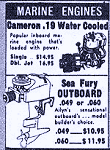 Outboard motors for model boats have been
available for a long time. Advertisements in modeling magazines from the 1950s (as
far back as my collection goes) has plenty of them.
Ailyn's Sea Fury outboard
motor and the Fuji outboard motors are just a couple examples for which I have
copies of the ads. I don't know if any are still manufactured today, but if you
hang around eBay long enough, you will find them up for auction. As of this writing,
there is a Fuji .15 outboard motor up for bid. It appears to me in remarkably good
condition. These two advertisements were scanned from 1950s vintage American
Modeler magazines, offered by America's Hobby Center (no longer in business)
in New York City. According to the U.S. Bureau of Labor Statistics' inflation calculator
the $29.95 price in 1957 would be $313.59 in 2011 money. These vintage motors usually
sell at about the inflation-adjusted price, so when you see them go for a couple
hundred dollars, it really is not so much in today's money... Outboard motors for model boats have been
available for a long time. Advertisements in modeling magazines from the 1950s (as
far back as my collection goes) has plenty of them.
Ailyn's Sea Fury outboard
motor and the Fuji outboard motors are just a couple examples for which I have
copies of the ads. I don't know if any are still manufactured today, but if you
hang around eBay long enough, you will find them up for auction. As of this writing,
there is a Fuji .15 outboard motor up for bid. It appears to me in remarkably good
condition. These two advertisements were scanned from 1950s vintage American
Modeler magazines, offered by America's Hobby Center (no longer in business)
in New York City. According to the U.S. Bureau of Labor Statistics' inflation calculator
the $29.95 price in 1957 would be $313.59 in 2011 money. These vintage motors usually
sell at about the inflation-adjusted price, so when you see them go for a couple
hundred dollars, it really is not so much in today's money...
 The flying business was big business in the
early days of aviation. From the beginning, specialized training and certification
was needed to be trusted in the air with mail, cargo, and the lives of strangers.
As with today, a flyboy could teach himself to fly and put his own neck on the line
(only with ultralights now, though), but anything more meant graduating from a college
curriculum and/or getting training from the military. The Civil Aeronautics Authority
(CAA, now the Federal Aviation Administration cum FAA), oversaw non-military flights
and its Civilian Pilot Training Program (CPTP) regulated and certified private schools
for teaching aspiring pilots aerodynamics, mechanics, weather phenomena, airframe
and powerplant maintenance, rules and regulations, public relations, and other necessary
skills. This "Youth
Air Movement News" column from the December 1939 issue of Flying Aces
magazine reported on the progress of the program, and mentioned here that women
were being permitted into the flying schools as well... The flying business was big business in the
early days of aviation. From the beginning, specialized training and certification
was needed to be trusted in the air with mail, cargo, and the lives of strangers.
As with today, a flyboy could teach himself to fly and put his own neck on the line
(only with ultralights now, though), but anything more meant graduating from a college
curriculum and/or getting training from the military. The Civil Aeronautics Authority
(CAA, now the Federal Aviation Administration cum FAA), oversaw non-military flights
and its Civilian Pilot Training Program (CPTP) regulated and certified private schools
for teaching aspiring pilots aerodynamics, mechanics, weather phenomena, airframe
and powerplant maintenance, rules and regulations, public relations, and other necessary
skills. This "Youth
Air Movement News" column from the December 1939 issue of Flying Aces
magazine reported on the progress of the program, and mentioned here that women
were being permitted into the flying schools as well...
 "The 2,000 rpm permanent magnet electric
motor has been developed in a partnership with
Hybrid Air Vehicles and the University of Nottingham, where Collins has begun
basic characterization testing of the motor. Collins said it is targeting specific
power density levels of 9kW/kg and 98% efficiency using a novel motor topology and
composite construction. The company is designing the motor at its Electronic Controls
and Motor Systems Centre of Excellence in Solihull where it is also developing its
1 MW electric motor and motor controller for the Pratt & Whitney Canada
(P&WC) regional hybrid-electric flight demonstrator. The two motors are part
of Collins' technology roadmap for the development of a family of electric motors
that can be appropriately scaled to meet the needs of hybrid-electric and all-electric
applications across multiple aircraft segments..." "The 2,000 rpm permanent magnet electric
motor has been developed in a partnership with
Hybrid Air Vehicles and the University of Nottingham, where Collins has begun
basic characterization testing of the motor. Collins said it is targeting specific
power density levels of 9kW/kg and 98% efficiency using a novel motor topology and
composite construction. The company is designing the motor at its Electronic Controls
and Motor Systems Centre of Excellence in Solihull where it is also developing its
1 MW electric motor and motor controller for the Pratt & Whitney Canada
(P&WC) regional hybrid-electric flight demonstrator. The two motors are part
of Collins' technology roadmap for the development of a family of electric motors
that can be appropriately scaled to meet the needs of hybrid-electric and all-electric
applications across multiple aircraft segments..."
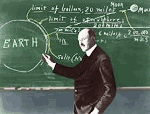 It was on March 16, 1926, that
Robert
Goddard made history in Auburn, Massachusetts, by successfully launching the
world's first liquid fueled rocket. The propellant was a mixture of gasoline and
liquid oxygen. That was a mere ten year prior to this article that appeared in
Boys' Life magazine. Author T.E. Mussen comments that as of the writing,
"thus far the rocket has carried neither men nor recording instruments, nothing
more than the source of its own propelling power." Breathtaking speeds of 700 mph
had been attained and altitudes of 7,500 feet staggered the imagination with impossible
proposals - like someday sending human beings to the moon. The oft referenced American
Rocket Society (ARS) was created in 1930, and was the leading professional group
for advancing rocket science. The group was planning for such missions three decades
before they became reality. ARS was merged with the Institute of Aerospace Sciences
in 1963 to become the present day American Institute of Aeronautics and Astronautics
(AIAA)... It was on March 16, 1926, that
Robert
Goddard made history in Auburn, Massachusetts, by successfully launching the
world's first liquid fueled rocket. The propellant was a mixture of gasoline and
liquid oxygen. That was a mere ten year prior to this article that appeared in
Boys' Life magazine. Author T.E. Mussen comments that as of the writing,
"thus far the rocket has carried neither men nor recording instruments, nothing
more than the source of its own propelling power." Breathtaking speeds of 700 mph
had been attained and altitudes of 7,500 feet staggered the imagination with impossible
proposals - like someday sending human beings to the moon. The oft referenced American
Rocket Society (ARS) was created in 1930, and was the leading professional group
for advancing rocket science. The group was planning for such missions three decades
before they became reality. ARS was merged with the Institute of Aerospace Sciences
in 1963 to become the present day American Institute of Aeronautics and Astronautics
(AIAA)...
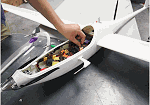 Here's what you get when a non-modeler writes
a headline about an e-powered sailplane. Clearly, the photo shows a motor in the
nose, and unless it is hauled aloft by the Ingenuity coaxial helicopter (which it
won't be) or some sort of winch is installed on the surface (which won't be), the
craft needs a motor. It will also need wheels. The story begins begins: "Eight active
spacecraft, including three operated by NASA, orbit Mars, gathering imagery of the
planet's surface at a resolution of about 1 foot per pixel. Three rovers traverse
the ground, mapping small areas of the planet with greater precision. But what lies
in the hundreds of kilometers between the rovers and the orbiters - including atmospheric
climate processes and geological features like volcanoes and canyons - is often
of most interest to planetary scientists. 'You have this really important, critical
piece in this planetary boundary layer, like in the first few kilometers above the
ground..." Here's what you get when a non-modeler writes
a headline about an e-powered sailplane. Clearly, the photo shows a motor in the
nose, and unless it is hauled aloft by the Ingenuity coaxial helicopter (which it
won't be) or some sort of winch is installed on the surface (which won't be), the
craft needs a motor. It will also need wheels. The story begins begins: "Eight active
spacecraft, including three operated by NASA, orbit Mars, gathering imagery of the
planet's surface at a resolution of about 1 foot per pixel. Three rovers traverse
the ground, mapping small areas of the planet with greater precision. But what lies
in the hundreds of kilometers between the rovers and the orbiters - including atmospheric
climate processes and geological features like volcanoes and canyons - is often
of most interest to planetary scientists. 'You have this really important, critical
piece in this planetary boundary layer, like in the first few kilometers above the
ground..."
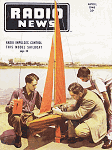 As you can tell from all the vintage modeling
and electronics magazine I own and use to post various article, I am prone to waxing
nostalgic about the days of yore. Being born in 1958, I am part of the last generation
of people brought up at a time when patriotism, courtesy, manners, and civility
was taught in school and in the public square by fellow citizens and even politicians.
However, there are limits to my desire to enjoy the environment of the good 'ole
days, and one of them is the need to build (often), tune, and repair nearly all
the electronic equipment used in model aviation and model boating activities. This
"Radio
Controlled Model Sailboat" article from a 1948 issue of Radio News
magazine is a prime example of what I mean. While knowing how to do all the work
involved in the system created by these two Raytheon engineers is a great achievement,
the work involved is extremely time consuming and takes away significantly from
the time actually spent enjoying sailing the boat. Modern compact, powerful, reliable,
relatively inexpensive, fully proportional, feature-packed radio systems are much
preferred over the former. Here is a short tale of my own venture into R/C sailboating
with a Thunder Tiger Victoria sloop, circa 2000... As you can tell from all the vintage modeling
and electronics magazine I own and use to post various article, I am prone to waxing
nostalgic about the days of yore. Being born in 1958, I am part of the last generation
of people brought up at a time when patriotism, courtesy, manners, and civility
was taught in school and in the public square by fellow citizens and even politicians.
However, there are limits to my desire to enjoy the environment of the good 'ole
days, and one of them is the need to build (often), tune, and repair nearly all
the electronic equipment used in model aviation and model boating activities. This
"Radio
Controlled Model Sailboat" article from a 1948 issue of Radio News
magazine is a prime example of what I mean. While knowing how to do all the work
involved in the system created by these two Raytheon engineers is a great achievement,
the work involved is extremely time consuming and takes away significantly from
the time actually spent enjoying sailing the boat. Modern compact, powerful, reliable,
relatively inexpensive, fully proportional, feature-packed radio systems are much
preferred over the former. Here is a short tale of my own venture into R/C sailboating
with a Thunder Tiger Victoria sloop, circa 2000...
 "Lockheed Martin and the U.S. Air Force have
successfully conducted a
hypersonic-boosted flight test of the AGM-183A Air-launched Rapid Response Weapon
(ARRW) from the service's B-52H Stratofortress. The successful flight demonstrated
the weapon’s ability to reach and withstand operational hypersonic speeds, collect
data for use in further flight tests, and validate safe separation from the aircraft
to deliver the glide body and warhead to designated targets from significant standoff
distances. Dave Berganini, vice president of Hypersonic and Strike Systems at Lockheed
Martin Missiles and Fire Control said that the need for hypersonic strike capabilities
is critical to the USA, with the successful test helping to maintain 'an accelerated
and rigorous timeline.' Additional booster and all-up-round test flights will continue
throughout 2022, before reaching Early Operational Capability (EOC) in 2023..." "Lockheed Martin and the U.S. Air Force have
successfully conducted a
hypersonic-boosted flight test of the AGM-183A Air-launched Rapid Response Weapon
(ARRW) from the service's B-52H Stratofortress. The successful flight demonstrated
the weapon’s ability to reach and withstand operational hypersonic speeds, collect
data for use in further flight tests, and validate safe separation from the aircraft
to deliver the glide body and warhead to designated targets from significant standoff
distances. Dave Berganini, vice president of Hypersonic and Strike Systems at Lockheed
Martin Missiles and Fire Control said that the need for hypersonic strike capabilities
is critical to the USA, with the successful test helping to maintain 'an accelerated
and rigorous timeline.' Additional booster and all-up-round test flights will continue
throughout 2022, before reaching Early Operational Capability (EOC) in 2023..."
 Bill Hannan was a prolific designer of and
author of magazine articles and books about free flight models. His contributions
spanned more than fifty years. Many of his designs, like the
Flyangle,
targeted beginners. It appeared in the March 1970 issue of American Aircraft
Modeler magazine His goal was to present models that were easy to build and
that were constructed in such a manner as to virtually guaranty success. Based on
the inherently rigid, warp resistant triangular features of the AMA's Delta Dart,
Hannan's Flyangle introduces a built-up fuselage with a triangular cross-section.
It is the next logical step up from the Delta Dart. Airplanes and Rockets website
visitor Ray M. wrote to request this article. It's nice to know there are still
purists out there building these models... Bill Hannan was a prolific designer of and
author of magazine articles and books about free flight models. His contributions
spanned more than fifty years. Many of his designs, like the
Flyangle,
targeted beginners. It appeared in the March 1970 issue of American Aircraft
Modeler magazine His goal was to present models that were easy to build and
that were constructed in such a manner as to virtually guaranty success. Based on
the inherently rigid, warp resistant triangular features of the AMA's Delta Dart,
Hannan's Flyangle introduces a built-up fuselage with a triangular cross-section.
It is the next logical step up from the Delta Dart. Airplanes and Rockets website
visitor Ray M. wrote to request this article. It's nice to know there are still
purists out there building these models...
 This website
exists entirely on the support of its visitors by way of a small percentage earned
with your
Amazon.com purchases. It typically works out to less than $10
per month. That barley covers the domain registration and secure server fees. If
you plan to buy items via
Amazon.com, please begin your shopping session from the AirplanesAndRockets.com
website so that I get credit for it. Doing so does not cost you anything extra.
Thank you for your support. This website
exists entirely on the support of its visitors by way of a small percentage earned
with your
Amazon.com purchases. It typically works out to less than $10
per month. That barley covers the domain registration and secure server fees. If
you plan to buy items via
Amazon.com, please begin your shopping session from the AirplanesAndRockets.com
website so that I get credit for it. Doing so does not cost you anything extra.
Thank you for your support.
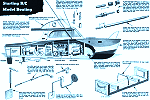 Radio controlled (R/C) model boating has
been around since the 1940s, but prior to about when this "Starting R/C Model Boating"
article appeared in the 1960 Annual issue of Air Trails magazine, the electronic
gear required for operation was primarily in the realm of those who were adept enough
at electronics to design and/or build their own equipment. Commercial rigs were
available on the open market, but they were expensive. Most craft built in the early
days of R/C model boating were scale models of leisure craft or of military ships.
High speed racing boats, although they could be found, came later as equipment got
smaller in size and weight. Unlike today where ready-to-run radio controlled boats
can be purchased for a relatively low price, in 1960 the boating enthusiast had
to build most of the running hardware himself using tubing, wire, and sheet metal.
Producing something like this electric motor powered cabin cruiser was a monumental
project that took a lot of time. Of course most people had more time and will to
devote to constructive hobbies before the era of 500 television channels to zombie
out on, or Internet access from computers or cellphones... Radio controlled (R/C) model boating has
been around since the 1940s, but prior to about when this "Starting R/C Model Boating"
article appeared in the 1960 Annual issue of Air Trails magazine, the electronic
gear required for operation was primarily in the realm of those who were adept enough
at electronics to design and/or build their own equipment. Commercial rigs were
available on the open market, but they were expensive. Most craft built in the early
days of R/C model boating were scale models of leisure craft or of military ships.
High speed racing boats, although they could be found, came later as equipment got
smaller in size and weight. Unlike today where ready-to-run radio controlled boats
can be purchased for a relatively low price, in 1960 the boating enthusiast had
to build most of the running hardware himself using tubing, wire, and sheet metal.
Producing something like this electric motor powered cabin cruiser was a monumental
project that took a lot of time. Of course most people had more time and will to
devote to constructive hobbies before the era of 500 television channels to zombie
out on, or Internet access from computers or cellphones...
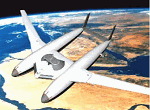 Here
is a unique concept called the "Gravity Plane" that
theoretically can take off, climb to altitude, cruise, descend, and land using only
stored helium and built-in air compressors. Conceived of by Robert D. Hunt of Hunt
Aviation†, it purports to be entirely self-powered, but in reality we know that
conservation of energy requires that 100% efficiency be realized in order for that
to be so. Still, it is an interesting idea. There are currently automated, unmanned
submarines that employ a similar principle for bobbing up and down through the oceans
to collect research data. While there are lots of technical hurdles to overcome,
it is an approach to "clean" flight that should be explored further, if for no other
reason than to rule it out as a possibility. Maybe this would make a good radio
controlled modeling project for someone. I'd do it, but just don't have the time.
Come to think of it, there might be some stimulus money out there for funding such
a green concept... Here
is a unique concept called the "Gravity Plane" that
theoretically can take off, climb to altitude, cruise, descend, and land using only
stored helium and built-in air compressors. Conceived of by Robert D. Hunt of Hunt
Aviation†, it purports to be entirely self-powered, but in reality we know that
conservation of energy requires that 100% efficiency be realized in order for that
to be so. Still, it is an interesting idea. There are currently automated, unmanned
submarines that employ a similar principle for bobbing up and down through the oceans
to collect research data. While there are lots of technical hurdles to overcome,
it is an approach to "clean" flight that should be explored further, if for no other
reason than to rule it out as a possibility. Maybe this would make a good radio
controlled modeling project for someone. I'd do it, but just don't have the time.
Come to think of it, there might be some stimulus money out there for funding such
a green concept...
 Flying model helicopter development understandably
took a lot longer than airplanes because of the complex aerodynamic and mechanical
issues that needed to be conquered for successful operation. A few direct drive
rotor systems appeared early on, with the engine mounted in the fuselage, but a
counter-torque force needed to be dealt with as the fuselage wanted to rotate in
the opposite direction as the rotors. Ken Norris' implementation as shown in this
1961 issue of American Modeler magazine, solved that problem by mounting
a pair of engines on a boom that was part of the rotor head assembly. Doing so meant
the only torque transferred to the fuselage was due to any friction between the
free-wheeling rotor shaft and the bearings, and due to accelerations during rotor
speed changes. The physical size... Flying model helicopter development understandably
took a lot longer than airplanes because of the complex aerodynamic and mechanical
issues that needed to be conquered for successful operation. A few direct drive
rotor systems appeared early on, with the engine mounted in the fuselage, but a
counter-torque force needed to be dealt with as the fuselage wanted to rotate in
the opposite direction as the rotors. Ken Norris' implementation as shown in this
1961 issue of American Modeler magazine, solved that problem by mounting
a pair of engines on a boom that was part of the rotor head assembly. Doing so meant
the only torque transferred to the fuselage was due to any friction between the
free-wheeling rotor shaft and the bearings, and due to accelerations during rotor
speed changes. The physical size...
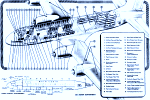 The Douglas DC−3 (C−47 was the military
version designation) has always been my favorite twin engined commercial airplane.
Its nickname of "Gooney Bird" amongst troops is undeserved IMHO. The DC−3 is credited
with launching the commercial airline industry, and its C−47 version was listed
by Dwight D. Eisenhower as being on the most important tools for winning World War II.
Edward F. Burton, Chief Engineer at Douglas Aircraft Company, runs through the evolution
of the DC−3 and it predecessors and descendants in this December 1945 issue of
Flying Age magazine. December of 1935 marked the maiden flight of the DC−2,
was was a direct follow-on the the DC−2. A single DC−4 (4 engines) was built and
delivered to Japan. Then a DC−5 was built (high-wing version of the DC−3) but never
went into production. The 4-engine DC−6 entered commercial service in 1946, followed
by the very popular DC−7. A coaxial, counter-rotating pusher prop model DC−8 (not
to be confused with the 4-engine commercial DC−8 jet) never made it off the drawing
board. The next iteration was the C−54, which... The Douglas DC−3 (C−47 was the military
version designation) has always been my favorite twin engined commercial airplane.
Its nickname of "Gooney Bird" amongst troops is undeserved IMHO. The DC−3 is credited
with launching the commercial airline industry, and its C−47 version was listed
by Dwight D. Eisenhower as being on the most important tools for winning World War II.
Edward F. Burton, Chief Engineer at Douglas Aircraft Company, runs through the evolution
of the DC−3 and it predecessors and descendants in this December 1945 issue of
Flying Age magazine. December of 1935 marked the maiden flight of the DC−2,
was was a direct follow-on the the DC−2. A single DC−4 (4 engines) was built and
delivered to Japan. Then a DC−5 was built (high-wing version of the DC−3) but never
went into production. The 4-engine DC−6 entered commercial service in 1946, followed
by the very popular DC−7. A coaxial, counter-rotating pusher prop model DC−8 (not
to be confused with the 4-engine commercial DC−8 jet) never made it off the drawing
board. The next iteration was the C−54, which...
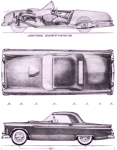 In 1955, Ford introduced the Thunderbird
convertible as its first true "modern" personal luxury car. It was not promoted
as a sports car, although its 2-seat configuration certainly provided the requisite
look. As with all new model years, the
1955 Ford Thunderbird
was introduced to the public in the fall of 1954, in time for the December edition
of Air Trails to publish a series of scale pencil drawings by Jefferies. The artist
much have had access to at least some level of factory drawings because of the detail
in the x-ray views; either that or he had an exceptional ability to visualize such
things based only on external observations. If you are a Thunderbird fan, then you
will appreciate these drawings... In 1955, Ford introduced the Thunderbird
convertible as its first true "modern" personal luxury car. It was not promoted
as a sports car, although its 2-seat configuration certainly provided the requisite
look. As with all new model years, the
1955 Ford Thunderbird
was introduced to the public in the fall of 1954, in time for the December edition
of Air Trails to publish a series of scale pencil drawings by Jefferies. The artist
much have had access to at least some level of factory drawings because of the detail
in the x-ray views; either that or he had an exceptional ability to visualize such
things based only on external observations. If you are a Thunderbird fan, then you
will appreciate these drawings...
 "Eviation’s sleek,
all-electric airplane demonstrator–dubbed Alice–reportedly completed a
low speed taxi testing program this month at Arlington Municipal Airport (KAWO),
in Washington, north of Seattle, and is “gearing up” for its first flight “this
summer.” The FlightGlobal report, from the European Business Aviation Conference
and Exhibition (EBACE 2022) in Geneva, quotes interim CEO Gregory Davis, who said
low-speed ground testing finished on May 2, with Alice achieving a maximum speed
of 86 kts. High-speed taxi testing won’t be attempted until Alice has received an
experimental permit to fly, Davis told FlightGlobal Tuesday. In April, Eviation
told FLYING it was conducting a parallel process of ground testing and safety board
reviews. Based on the ground test results—Davis told FlightGlobal that Eviation
has slowed down its timeline..." "Eviation’s sleek,
all-electric airplane demonstrator–dubbed Alice–reportedly completed a
low speed taxi testing program this month at Arlington Municipal Airport (KAWO),
in Washington, north of Seattle, and is “gearing up” for its first flight “this
summer.” The FlightGlobal report, from the European Business Aviation Conference
and Exhibition (EBACE 2022) in Geneva, quotes interim CEO Gregory Davis, who said
low-speed ground testing finished on May 2, with Alice achieving a maximum speed
of 86 kts. High-speed taxi testing won’t be attempted until Alice has received an
experimental permit to fly, Davis told FlightGlobal Tuesday. In April, Eviation
told FLYING it was conducting a parallel process of ground testing and safety board
reviews. Based on the ground test results—Davis told FlightGlobal that Eviation
has slowed down its timeline..."
 Here is a list of
model airplane, helicopter, rocket, and boat videos
put together around 2008. As you might expect, by now many of the websites and/or
the original content are gone. Where possible, I located missing material on the
Archive.org website (the Wayback Machine). Links I couldn't find anywhere have been
deleted. Many of the videos are ones I created for the Airplanes and Rockets website... Here is a list of
model airplane, helicopter, rocket, and boat videos
put together around 2008. As you might expect, by now many of the websites and/or
the original content are gone. Where possible, I located missing material on the
Archive.org website (the Wayback Machine). Links I couldn't find anywhere have been
deleted. Many of the videos are ones I created for the Airplanes and Rockets website...
 This is incredible,
and the best is yet to come. "We're less than one week away from the July 12, 2022,
release of the first science-quality images from NASA's
James Webb Space Telescope, but how does the observatory find and lock onto
its targets? Webb's Fine Guidance Sensor (FGS), developed by the Canadian Space
Agency, was designed with this particular question in mind. Recently it captured
a view of stars and galaxies that provides a tantalizing glimpse at what the telescope's
science instruments will reveal in the coming weeks, months, and years. FGS has
always been capable of capturing imagery, but its primary purpose is to enable accurate
science measurements and imaging with precision pointing. When it does capture imagery,
it is typically not kept: given the limited communications bandwidth between L2
and Earth, Webb only sends data from up to two science instruments at a time. But
during the week-long stability test in May, it occurred to the team that they could
keep the imagery that was being captured because there was available data transfer
bandwidth. The engineering test image - produced during a thermal stability test
in mid-May..." This is incredible,
and the best is yet to come. "We're less than one week away from the July 12, 2022,
release of the first science-quality images from NASA's
James Webb Space Telescope, but how does the observatory find and lock onto
its targets? Webb's Fine Guidance Sensor (FGS), developed by the Canadian Space
Agency, was designed with this particular question in mind. Recently it captured
a view of stars and galaxies that provides a tantalizing glimpse at what the telescope's
science instruments will reveal in the coming weeks, months, and years. FGS has
always been capable of capturing imagery, but its primary purpose is to enable accurate
science measurements and imaging with precision pointing. When it does capture imagery,
it is typically not kept: given the limited communications bandwidth between L2
and Earth, Webb only sends data from up to two science instruments at a time. But
during the week-long stability test in May, it occurred to the team that they could
keep the imagery that was being captured because there was available data transfer
bandwidth. The engineering test image - produced during a thermal stability test
in mid-May..."
 As was the case with many magazines up through
about the 1970's, comics reflecting the theme of the publication was often found
within the pages of each issue. This 1960 edition of American Modeler magazine
is a good example. It contained no fewer than six
model
aviation themed comics, one related to a particular advertisement for the Fox
Glo−Master Battery and Plug, and five stand-alone comics. The Table of Contents
(TOC) page often had a "silent" comic with no dialog or caption. In fact the comic
that spanned both pages 42 and 43 is like typical TOC comic. The control line combat
scenario on page 49 reminds me of something you'd see on the old BattleBots show
(which I haven't seen in many years, but is evidently still running). Anyway, enjoy
them all! As was the case with many magazines up through
about the 1970's, comics reflecting the theme of the publication was often found
within the pages of each issue. This 1960 edition of American Modeler magazine
is a good example. It contained no fewer than six
model
aviation themed comics, one related to a particular advertisement for the Fox
Glo−Master Battery and Plug, and five stand-alone comics. The Table of Contents
(TOC) page often had a "silent" comic with no dialog or caption. In fact the comic
that spanned both pages 42 and 43 is like typical TOC comic. The control line combat
scenario on page 49 reminds me of something you'd see on the old BattleBots show
(which I haven't seen in many years, but is evidently still running). Anyway, enjoy
them all!
 "Aquitivity
Roundup" was a monthly column in American Modeler magazine (the precursor to
American Aircraft Modeler, precursor to the current Model Aviation). American Modeler
covered many aspects of modeling other than airplanes including rockets, boats,
cars, and to a lesser extent, trains and helicopters (helis were for experimenters
at the time). Radio control for models boats was in full swing by 1962, both for
engine and wind power. Just as with model airplanes, model boats were run as free
float (a la free flight - get it?), on a tether (a la control line) and
by remote control (could be via sound, light, or radio signals)... "Aquitivity
Roundup" was a monthly column in American Modeler magazine (the precursor to
American Aircraft Modeler, precursor to the current Model Aviation). American Modeler
covered many aspects of modeling other than airplanes including rockets, boats,
cars, and to a lesser extent, trains and helicopters (helis were for experimenters
at the time). Radio control for models boats was in full swing by 1962, both for
engine and wind power. Just as with model airplanes, model boats were run as free
float (a la free flight - get it?), on a tether (a la control line) and
by remote control (could be via sound, light, or radio signals)...
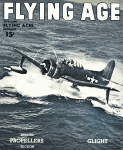 One of the motivations for posting these
photos from a 1945 issue of
Flying Age magazine is the appearance of an F2G Corsair, of which I own
a Cox control line model from back in the 1960's. Having been published shortly
after the end of World War II, there are some things being shown that probably
would not have been declassified a year earlier, like the De Havilland Vampire jet
airplane. I have to admit to not knowing what the "pannier" was mounted to the belly
of the converted Halifax bomber. A pannier is a basket, as most cyclists probably
know. The word derives from the Old French "panier," meaning bread basket. Another
bit of news to me was the "Lily" portable sea-drome that simulated aircraft carrier
conditions to help train pilots for takeoffs and landings on the oceans. Another
very interesting item is the "tube" which housed three Jake reconnaissance planes
aboard a giant "Jap" submarine... One of the motivations for posting these
photos from a 1945 issue of
Flying Age magazine is the appearance of an F2G Corsair, of which I own
a Cox control line model from back in the 1960's. Having been published shortly
after the end of World War II, there are some things being shown that probably
would not have been declassified a year earlier, like the De Havilland Vampire jet
airplane. I have to admit to not knowing what the "pannier" was mounted to the belly
of the converted Halifax bomber. A pannier is a basket, as most cyclists probably
know. The word derives from the Old French "panier," meaning bread basket. Another
bit of news to me was the "Lily" portable sea-drome that simulated aircraft carrier
conditions to help train pilots for takeoffs and landings on the oceans. Another
very interesting item is the "tube" which housed three Jake reconnaissance planes
aboard a giant "Jap" submarine...
 Flying Aces magazine featured a monthly
"Aviation
News" column that covered both model and full-size aviation happenings across
the country and on foreign soil. This 1934 issue reported on the land-based "lighthouses"
which were established throughout the land in order to guide airplanes from airport
to airport. Not much in the way of radio direction finding was available at the
time, and this method was more consistent and reliable than having farmers build
bonfires in their fields for pilots to look for. "Dead reckoning" was still the
order of the day back then. Compared to today where only in the most remote areas
are lacking any manmade visual object to positive identification while navigating,
real "seat of the pants" skill was required to fly cross-country routes without
getting lost. Nowadays, GPS-linked and/or inertial navigation systems can flying
an airplane from point A to point B without any assistance from a human. Also
told... Flying Aces magazine featured a monthly
"Aviation
News" column that covered both model and full-size aviation happenings across
the country and on foreign soil. This 1934 issue reported on the land-based "lighthouses"
which were established throughout the land in order to guide airplanes from airport
to airport. Not much in the way of radio direction finding was available at the
time, and this method was more consistent and reliable than having farmers build
bonfires in their fields for pilots to look for. "Dead reckoning" was still the
order of the day back then. Compared to today where only in the most remote areas
are lacking any manmade visual object to positive identification while navigating,
real "seat of the pants" skill was required to fly cross-country routes without
getting lost. Nowadays, GPS-linked and/or inertial navigation systems can flying
an airplane from point A to point B without any assistance from a human. Also
told...
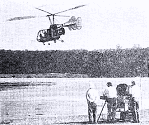 This angled, twin rotor, no-tail-rotor (NOTAR)
configuration for a remotely controlled helicopter was pioneered by
Kaman Aircraft Corporation in the 1950s, and is still a unique part of their
product lineup today. Per their website, "The Unmanned Aerial Truck (UAT) continues
a Kaman tradition of pioneering unmanned helicopters. In 1957, Charles Kaman, founder
of Kaman Corporation, created the first pilotless aircraft." The embedded video
below is a 1957 edition of the "You Asked for It" television show, where host Jack
Smith reported on a demonstration of the craft. It is amazingly stable and easy
to fly, by a pilot in the cockpit, from a ground-based remote control station, or
from a remote control unit located in another airborne helicopter. As you will see,
this probably qualifies as the first practical first-person-view (FPV) remote controlled
aircraft... This angled, twin rotor, no-tail-rotor (NOTAR)
configuration for a remotely controlled helicopter was pioneered by
Kaman Aircraft Corporation in the 1950s, and is still a unique part of their
product lineup today. Per their website, "The Unmanned Aerial Truck (UAT) continues
a Kaman tradition of pioneering unmanned helicopters. In 1957, Charles Kaman, founder
of Kaman Corporation, created the first pilotless aircraft." The embedded video
below is a 1957 edition of the "You Asked for It" television show, where host Jack
Smith reported on a demonstration of the craft. It is amazingly stable and easy
to fly, by a pilot in the cockpit, from a ground-based remote control station, or
from a remote control unit located in another airborne helicopter. As you will see,
this probably qualifies as the first practical first-person-view (FPV) remote controlled
aircraft...
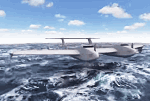 "The U.S. is seeking to develop a massive
new seaplane known as the
Liberty Lifter that will harness the ground effect to transport military payloads
over long distances. An X-plane project under the direction of DARPA, Liberty Lifter
will be designed to operate at sea for weeks at a time, capable of both water and
traditional runway landings. When traversing long distances across water, the seaplane
will seek to exploit the ground effect, flying just a few meters above the sea’s
surface to reduce drag and allow the aircraft to operate with high efficiency. The
concept has been successfully exploited in the past by the Soviet-era ekranoplans.
Known as Project 903, the Lun-class ekranoplan MD-160 came into service in 1987,
using the ground effect for efficient military logistics in and around the Caspian
Sea. Just one model was ever fully built..." "The U.S. is seeking to develop a massive
new seaplane known as the
Liberty Lifter that will harness the ground effect to transport military payloads
over long distances. An X-plane project under the direction of DARPA, Liberty Lifter
will be designed to operate at sea for weeks at a time, capable of both water and
traditional runway landings. When traversing long distances across water, the seaplane
will seek to exploit the ground effect, flying just a few meters above the sea’s
surface to reduce drag and allow the aircraft to operate with high efficiency. The
concept has been successfully exploited in the past by the Soviet-era ekranoplans.
Known as Project 903, the Lun-class ekranoplan MD-160 came into service in 1987,
using the ground effect for efficient military logistics in and around the Caspian
Sea. Just one model was ever fully built..."
 The May 1934 issue of Flying Aces
magazine contained another installment in the "Principles
of Model Building" series it ran for many months. This particular article introduces
formulas for calculating the area of various shapes ranging from a simple rectangle
to circles, parallelograms, triangles, trapezoids, and more. It also demonstrated
how to break irregular shapes into individual constituent shapes, calculate the
areas of each, and then add (or subtract) them for a total area. It is a relatively
simple procedure for anyone familiar with basic geometry, but many modelers are
not inclined toward the technical side of the physics and mathematics which define
govern flight. Calculation of area is necessary for determining wing loading, control
surface are ratios, volume (a bit more complicated, but easily an extension of area
calculation in three dimensions), etc. As a side note, while preparing the sketches
for posting here, I saw in Fig. 36 the definition of pi (π) and due to the
low original printing quality, the decimal point was barely visible so it appeared
to be at most a tiny random dot. The "1" is slanted so it looked like a division
line, so at first I though the author was giving π = 3 / 4 as a fractional estimate
of pi, which of course at 0.75 is way off of the standard estimate of 3.14. I therefore
inserted a prominent decimal point so the 3.14 would be obvious. BTW, a common fractional
estimate for pi is 22 / 7 = 3.145, which is only 0.001264 away from the actual value
of π to six decimal places (a mere 0.0402% error... The May 1934 issue of Flying Aces
magazine contained another installment in the "Principles
of Model Building" series it ran for many months. This particular article introduces
formulas for calculating the area of various shapes ranging from a simple rectangle
to circles, parallelograms, triangles, trapezoids, and more. It also demonstrated
how to break irregular shapes into individual constituent shapes, calculate the
areas of each, and then add (or subtract) them for a total area. It is a relatively
simple procedure for anyone familiar with basic geometry, but many modelers are
not inclined toward the technical side of the physics and mathematics which define
govern flight. Calculation of area is necessary for determining wing loading, control
surface are ratios, volume (a bit more complicated, but easily an extension of area
calculation in three dimensions), etc. As a side note, while preparing the sketches
for posting here, I saw in Fig. 36 the definition of pi (π) and due to the
low original printing quality, the decimal point was barely visible so it appeared
to be at most a tiny random dot. The "1" is slanted so it looked like a division
line, so at first I though the author was giving π = 3 / 4 as a fractional estimate
of pi, which of course at 0.75 is way off of the standard estimate of 3.14. I therefore
inserted a prominent decimal point so the 3.14 would be obvious. BTW, a common fractional
estimate for pi is 22 / 7 = 3.145, which is only 0.001264 away from the actual value
of π to six decimal places (a mere 0.0402% error...
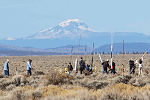 "Brothers is a place that has somehow slipped
outside the passage of time. Located in a sea of sagebrush in central Oregon, this
former stagecoach stopover once serviced horse-drawn migrants bound for the Willamette
Valley. When cars replaced carriages, the town transitioned to a highway fill station,
one of few in this arid and isolated expanse ... A clutch of attractive prefab homes
with nearby sheds, scrub pines, and satellite-dishes indicate some kind of human
presence, and a red and white schoolhouse is freshly painted ... The view from the
picnic tables is the same as from anywhere in Brothers: sage, rabbitbrush, greasewood,
and cheatgrass to the horizon. But you can turn southwest on the right afternoon
for a surprise: the unmistakable snarl of
rockets erupting from the steppe follows smoke trails across the sky. Thanks
to the nonprofit organization OregonRocketry, Brothers has outlasted the surrounding
ghost towns..." "Brothers is a place that has somehow slipped
outside the passage of time. Located in a sea of sagebrush in central Oregon, this
former stagecoach stopover once serviced horse-drawn migrants bound for the Willamette
Valley. When cars replaced carriages, the town transitioned to a highway fill station,
one of few in this arid and isolated expanse ... A clutch of attractive prefab homes
with nearby sheds, scrub pines, and satellite-dishes indicate some kind of human
presence, and a red and white schoolhouse is freshly painted ... The view from the
picnic tables is the same as from anywhere in Brothers: sage, rabbitbrush, greasewood,
and cheatgrass to the horizon. But you can turn southwest on the right afternoon
for a surprise: the unmistakable snarl of
rockets erupting from the steppe follows smoke trails across the sky. Thanks
to the nonprofit organization OregonRocketry, Brothers has outlasted the surrounding
ghost towns..."
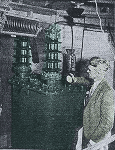 1934 was still riding the back of the high
voltage craze popularized by Nikola Tesla at the turn of the century. Super high
voltage spark gap transmitters were still being used in long distance communications
for special applications. William Haight was one of many people engaged in weather
manipulation - both its creation and destruction. Transportation, agriculture, and
recreation would greatly benefit from the ability to locally and temporarily control
weather. This story of Mr. Haight's high-voltage "electrodrome"
machine appeared in the May 1934 issue of Flying Aces magazine. Another
version of this electrodrome article by author Mel Wharton, entitled "Eliminating
the Peril of Fog," appeared in the April 1934 edition of Flying magazine.
There he says, "Repeated tests have shown that the operations of dispersing fog
is most effective at about 600,000 cycles - though work is done all the way on a
range from 500,000 to 1,500,000 cycles. The machine is capable of developing 500,000
volts, but only a fraction of this voltage is found necessary." A 4½ horsepower
gasoline engine-powered generator provides the voltage. A May 1935 issue of
Popular Mechanics magazine reports on Mr. Haight's electrodrome work... 1934 was still riding the back of the high
voltage craze popularized by Nikola Tesla at the turn of the century. Super high
voltage spark gap transmitters were still being used in long distance communications
for special applications. William Haight was one of many people engaged in weather
manipulation - both its creation and destruction. Transportation, agriculture, and
recreation would greatly benefit from the ability to locally and temporarily control
weather. This story of Mr. Haight's high-voltage "electrodrome"
machine appeared in the May 1934 issue of Flying Aces magazine. Another
version of this electrodrome article by author Mel Wharton, entitled "Eliminating
the Peril of Fog," appeared in the April 1934 edition of Flying magazine.
There he says, "Repeated tests have shown that the operations of dispersing fog
is most effective at about 600,000 cycles - though work is done all the way on a
range from 500,000 to 1,500,000 cycles. The machine is capable of developing 500,000
volts, but only a fraction of this voltage is found necessary." A 4½ horsepower
gasoline engine-powered generator provides the voltage. A May 1935 issue of
Popular Mechanics magazine reports on Mr. Haight's electrodrome work...
|


